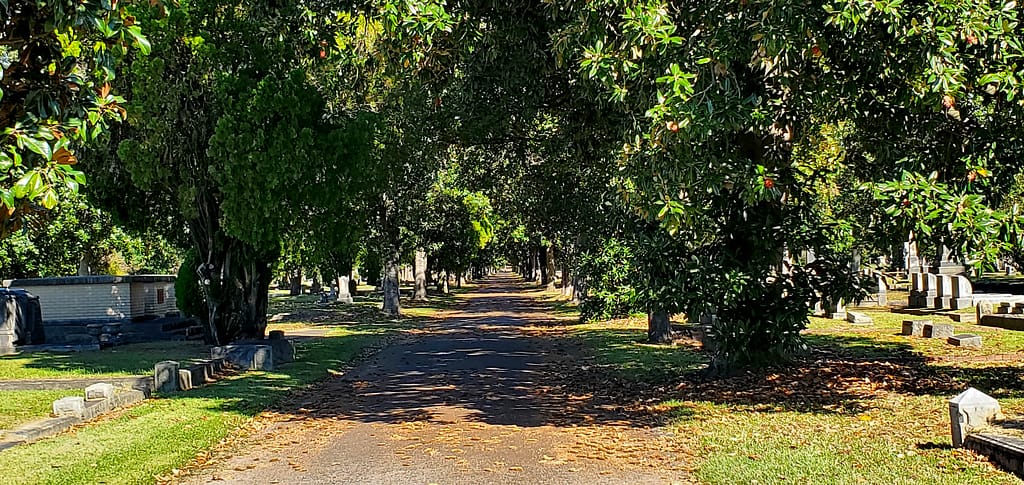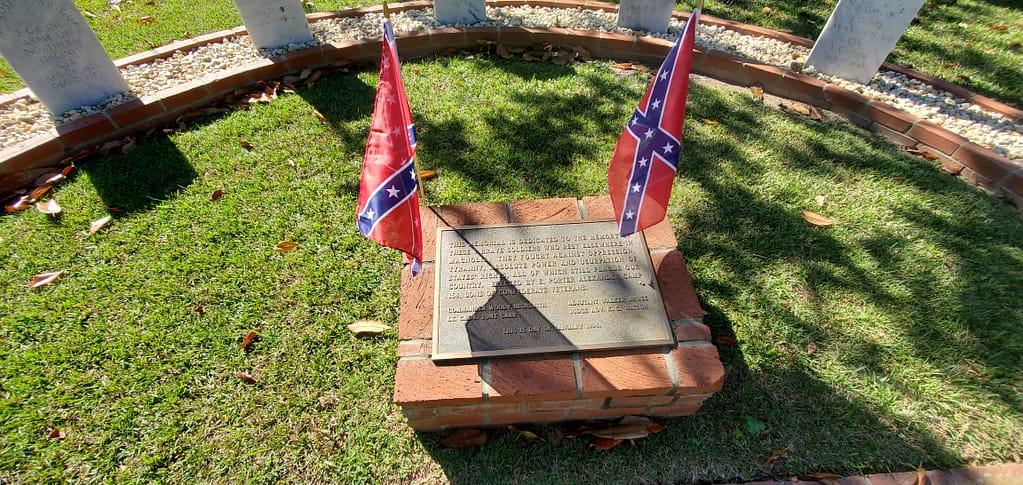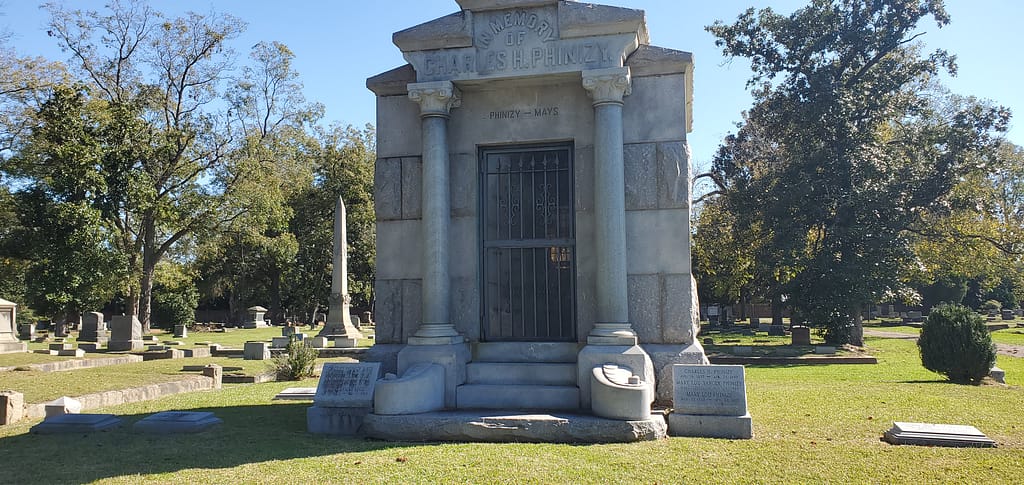
Magnolia Cemetery in Augusta stands as one of the most historic burial grounds in the state of Georgia. The City Council of Augusta originally bought the first two blocks of the cemetery in 1817 for the price of $800.1 The cemetery was once a plantation owned by French refugee Nicholas de l’Aigle, who donated most of the land it now stands on. Your feet feel every bit of the 60 acres if you choose to walk and explore. The journey is well worth it though, as the cemetery is home to several intriguing and notable grave sites that showcase its historic glory. Note the walkways as you traverse the cemetery which were constructed at De l’Aigles brickyard.2 Trees have pushed their roots up through the brick, making the paths look treacherous and haunting. But repaving these old walkways would likely mean some measure of destruction to the historic bricks that adorn them and no effortless task. There is also a symbolic beauty created by the tension that exists between the roots and the old bricks. As the wind blew gently through the Magnolia trees that are prominently found in the cemetery, leaves also litter the walkways and the surrounding gravesites. While cleaning these up regularly or more frequently would be best, their presence on the ground also inspires us to look up at where they are falling from, a gesture that few of us do enough. It’s also humbling to know that inmates and the DeLaigile family themselves, who now use the Americanized spelling of their last name, tend to most of the groundskeeping.

The cemetery also reminds us of Georgia’s past when exploring records of those buried there. Initially, the city council designated it as a graveyard for whites only, not uncommon for the period they conceived it in. But that legacy no longer exists. There are now five Jewish cemeteries on the grounds, along with a Greek cemetery, and a space for indigent residents and firefighters. The city still has some room for improvement addressing matters of division, though. In 2018, the city of Augusta held a bicentennial celebration of Magnolia Cemetery, but did not extend the same courtesy to nearby slave and black resident Cedar Grove Cemetery, which opened on the same day August 1, 1818.

There are nearly 337 Confederate soldiers buried in the cemetery, along with a handful of Union soldiers and veterans from other various conflicts prior to the Civil War. The oldest marker belongs to J. Hartford Montgomery, who died in 1800, giving evidence that the cemetery was likely used before its official designation in 1818.3 A half-circle of tombstones memorialize the seven Confederate generals buried on the grounds.

The marker is in an appropriate location, but represents the absolute pinnacle of revisionist history. The Sons of Confederate Veterans emplaced the plaque in 1994 and it willfully distorts the historical facts surrounding the catalyst for the Civil War. It reads, “This memorial is dedicated to the memory of these 7 brave soldiers who rest elsewhere in Magnolia. They fought against oppression, tyranny, absolute power and usurpation of states’ rights, all of which still plague our country.” These soldiers deserve a protected and revered burial place, even a monument erected to their lives, provided that the monument does not purposefully stand with incendiary untruth to the reasons for the Civil War. Historians have heard the argument against revisionist history claiming the war to be regarding “states’ rights” and answered in length. You can read more on this subject and the arguments against it here. It is a disservice to preservation and those who visit this site to perpetuate this egregious lie. Here are the 7 Generals buried at the site and their contributions:

Brigadier General Edward Porter Alexander

Graduate of West Point, who commanded 75 Confederate guns during Pickett’s Charge. Alexander was severely wounded at Petersburg, but rejoined his command in time to make the last march to Appomattox. After the war, he had a distinguished career as professor of engineering, railroad president, and author until his death in 1910.4
Brig. Gen. Goode Bryan

A planter, politician, and military officer. His brigade fought desperately in the Battle of the Wilderness until they exhausted all of their ammunition. Served as delegate to the Georgia secession convention in 1861. Resigned commission on September 20, 1864 due to chronic ill health. Established the Confederate Survivors Association and lived in Augusta, GA until his death in 1885.
Brig. Gen. Victor Jean Baptiste Girardey

Born 1837 in Lauw, France and emigrated to Georgia with his family in 1842. Orphaned at the age of 16, he was educated in New Orleans, LA. He first served in the Louisiana Militia. He later became a Captain and Assistant Adjutant-General for Brig. Gen. Ambrose Wright (also buried here). Distinguished himself in the Battle of the Crater, counterattacking after the Union Army’s mine exploded under the Confederate line and leading two brigades through. Girardey was shot in the head and killed during a direct defense against a Union Army assault on Fussell’s Mill in 1864.
Brig. Gen John King Jackson

Entered Confederate service in April 1861. Led the Army of the Mississippi in the Battle of Shiloh on April 6, 1862, charging a well-fortified Union position with a bayonet attack which was unsuccessful. In the Battle of Stones River, Lt. Gen Leonidas Polk ordered him to charge an enemy strongpoint, telling him, “Jackson, there’s the enemy, go in.” Jackson did so, and they cut his men to pieces. During Sherman’s March to the Sea in 1864, he took part in the siege of Savannah. After surrender, they paroled him from Augusta on May 17, 1865, and returned to civilian life as a lawyer. He died from pneumonia in early 1866, a few weeks after his 38th birthday.
Brig. Gen. William Duncan Smith

Smith was born in Augusta in 1825, and graduated 35th of 59 at West Point in 1846. He resigned U.S. commission on January 28, 1861 and entered Confederate service on March 16th. Smith led a detachment of Brig. Gen. “Shanks” Evan’s army and won the Battle of James Island. He later died of yellow fever on October 4, 1862.
Brig. Gen. Marcellus A. Stovall

Entered West Point in 1836, but resigned a year later due to poor health. Stovall served as Captain of Artillery for Georgia State Milita. He fought in the Battle of Stones River and in the Siege of Jackson in Mississippi in 1863. Stovall surrendered his command in North Carolina in the spring of 1865 and was paroled on May 9. After the war, he served as a cotton broker, then a merchant of farming supplies. Organized the Georgia Chemical Works, manufacturing fertilizers. He later served as city alderman in Augusta and was active in the Confederate Survivors Association. He died in 1895 at the age of 76 in Augusta, GA.
Maj. Gen. Ambrose Ranson Wright

Georgia commissioner to Maryland after secession in 1861. Fought and won the Battle of South Mills in April 1862, promoting him from a Colonel in the Georgia Infantry to Brigadier General. He later fought in the Army of Northern Virginia under Robert E. Lee and wounded at Antietam in 1862 and again at the Battle of Chancellorsville in 1863. In the Battle of Gettysburg, his brigade achieved the most successful penetration of the Union defense on July 2, 1863.

They fortified the eastern brick wall of the cemetery to defend attacks from Union troops in the Civil War. Most of the original brick still stands, along with defensive loopholes knocked out so that Confederate troops could provide retaliatory fire. Union forces never attacked the city, rendering the walls aesthetic, but they still stand today untouched.

John Martin’s plot is yet another prominent gravesite at the cemetery and a most unusual one. A Revolutionary War cannon that he brought home sits vertically at the foot of his plot. Martin died on Valentine’s Day 1843 at the age of 105. Outside of these veteran plots, there are many notable developers of the region and a plethora of average, everyday citizens. You can find a plaque dedicated to the Barrett legacy of Augusta while exploring, who contributed heavily to the development of Augusta from the building of the famed canal, the levee, and the hospital.

A few mausoleums adorn the cemetery, like the one belonging to Charles H. Phinizy, descendant to Ferdinand Victor Francois Phinizy, who was an Italian entrepreneur that settled the region in 1778.5 The most memorable, though, and most visited is that of Wylly Barron.

Augusta has a long history with superstition. Wylly Barron was a gambler whose fear ran deep. A dying curse by a losing gambler who committed suicide caused Barron to revise the rules in his gambling establishment, devote himself to many charities, and construct the mausoleum for himself 24 years before death, seen here. Barron was so superstitious that he directed they place his body in the vault, seal the door, and have the key thrown into the Savannah River. As far as we can tell, they carried his will out to the letter. His gambling hall in Atkinson Hotel on Ellis Street enacted a few unusual rules that were enforced by Barron himself. No one who handled money as a career or whose salary was insufficient enough to permit gambling could gamble in his place, and he also barred minors from playing there. Upon his death, he had lost a considerable amount and had no money to buy the prescribed metal coffin. They placed his remains directly into the vault, bricked it over, and sealed the keyhole. The epitaph reads: “Farewell vain work, I know enough of thee, And now am careless what thou sayest of me, Thy smiles I could not, nor thy frowns I fear, My cares are past, my head lies quiet here. What faults you knew of me, take care to shun, And look at home—, enough there’s to be done.”6
“You have taken everything I have. When you die, may you not have even a grave to shelter you!”
Dying Gambler (Unknown)
At the dead end of third street, marked by the worn signs throughout the cemetery, stands what they say to be the oldest tree in the state of Georgia. The Crape Myrtle tree was interesting to look at, but I have my doubts about the historicity of the claim that it is the oldest tree in Georgia, as I could find no primary source documents substantiating that claim. Nonetheless, it is certainly as old as they probably think it to be by arborist dating, and is worthy of protection, admiration, and respect.
- Augusta Museum of History, https://www.augustamuseum.org/Magnolia-Cemetery.
- Susan McCord, “Augusta’s Magnolia Cemetery Reaches 200-year Milestone,” The Augusta Chronicle, accessed March 2, 2021, https://www.augustachronicle.com/news/20180729/augustas-magnolia-cemetery-reaches-200-year-milestone.
- Dale Cox, “Magnolia Cemetery – Augusta, Georgia,” ExploreSouthernHistory.com, accessed March 2, 2021, https://www.exploresouthernhistory.com/augustamagnolia.html.
- “Notable Graves | Augusta, GA,” Augusta, GA – Official Website | Official Website, accessed March 2, 2021, https://www.augustaga.gov/1036/Notable-Graves.
- https://phinizycenter.org/our-history/
- “A Suicide’s Curse | Augusta, GA,” Augusta, GA – Official Website | Official Website, accessed March 2, 2021, https://www.augustaga.gov/1037/A-Suicides-Curse.


